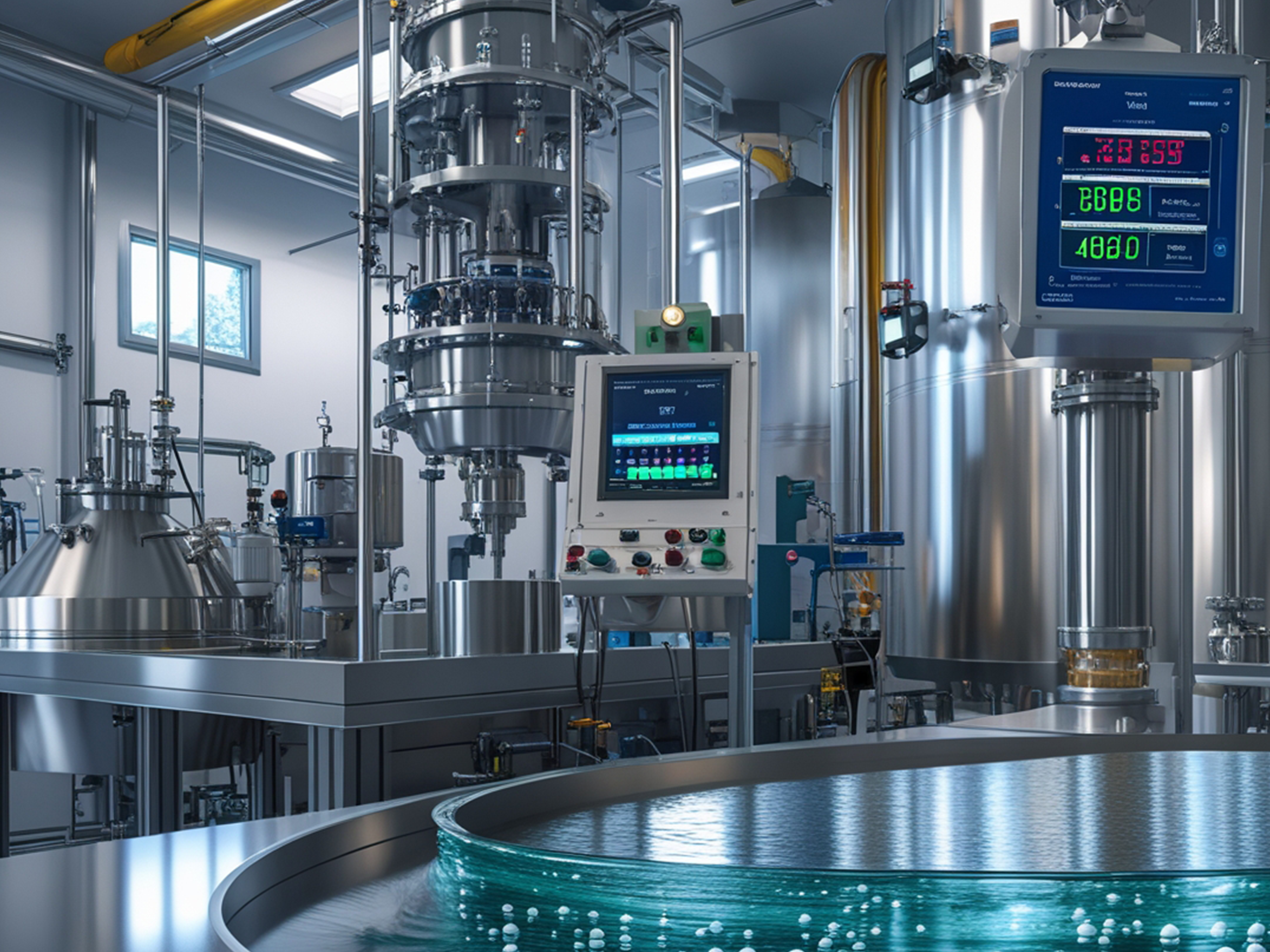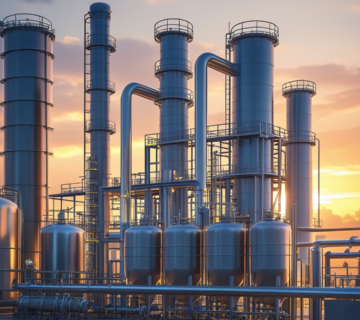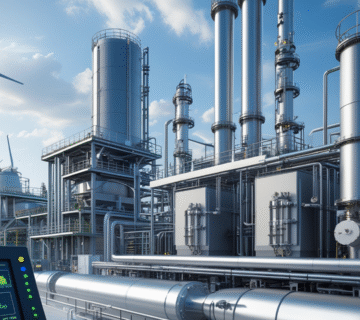Introduction
The formulation of anionic bitumen emulsions is a critical process in road construction, waterproofing, and pavement preservation. These emulsions provide cost-effective, energy-efficient, and environmentally friendly alternatives to conventional hot-applied bitumen, making them an essential component in modern infrastructure projects.
Anionic emulsions are composed of bitumen, water, and anionic emulsifiers, which allow the bitumen droplets to remain suspended in water until applied. The negative charge of these emulsions makes them ideal for alkaline aggregates such as limestone and dolomite, ensuring strong adhesion and durability in asphalt and paving applications.
Why Is Proper Formulation Important?
Formulating an anionic bitumen emulsion requires precise control over ingredient proportions, temperature, and mixing techniques. A poorly formulated emulsion can lead to:
❌ Phase separation, causing sedimentation and reduced shelf life
❌ Incorrect viscosity, affecting application performance
❌ Inconsistent adhesion, leading to early pavement failure
By following optimized formulation techniques, manufacturers can ensure stability, workability, and long-term performance of bitumen emulsions. This includes:
✅ Proper bitumen-to-water ratio to achieve desired consistency
✅ Optimal emulsifier selection to maintain particle dispersion
✅ pH adjustments to stabilize the negative charge of the bitumen droplets
Industrial Significance of Anionic Bitumen Emulsions
Anionic emulsions are widely used in various construction applications, including:
- Surface dressing for improved road durability
- Cold mix asphalt for flexible pavement solutions
- Fog seals and slurry seals to prevent oxidation in aging roads
- Soil stabilization for enhanced load-bearing capacity in construction sites
This guide provides a step-by-step process for formulating high-performance anionic bitumen emulsions, ensuring optimal quality control, stability, and efficiency in production.
For a detailed overview, visit Riyoniz Anionic Emulsion.
Understanding Anionic Bitumen Emulsions
Anionic bitumen emulsions are a specialized type of bitumen dispersion used in road construction, waterproofing, and pavement maintenance. Unlike conventional hot-applied bitumen, these emulsions allow for lower-temperature application, reducing energy consumption and improving workability.
1. What Makes an Emulsion “Anionic”?
The defining characteristic of an anionic emulsion is the negative charge on the bitumen droplets, which is achieved using anionic emulsifiers. These emulsifiers contain molecules with hydrophilic (water-attracting) and hydrophobic (bitumen-attracting) components, ensuring that bitumen remains evenly dispersed in water. The negative charge prevents droplets from clumping together, maintaining stability and uniformity in storage and application.
2. Why Use Anionic Emulsions?
Anionic emulsions are widely used in road construction and maintenance due to their unique benefits:
✅ Improved Adhesion to Alkaline Aggregates – Works exceptionally well with limestone, dolomite, and other high-pH materials.
✅ Cold Application – Reduces the need for excessive heating, leading to lower energy costs and fewer emissions.
✅ Environmentally Friendly – Produces fewer VOC emissions compared to traditional hot-applied bitumen.
✅ Longer Workability – Provides flexibility in application before breaking and curing.
3. Applications of Anionic Bitumen Emulsions
These emulsions are used in various road and pavement applications, including:
- Surface Dressing – Enhancing durability and weather resistance of roads.
- Cold Mix Asphalt – Used in low-temperature paving for cost efficiency.
- Fog Seals & Slurry Seals – Preserving and extending pavement life.
- Soil Stabilization – Strengthening subgrades in construction projects.
The choice of anionic emulsions over cationic emulsions depends largely on the aggregate type and environmental conditions. Since alkaline aggregates are negatively charged, they naturally repel cationic emulsions but bond well with anionic emulsions, making the latter a preferred choice for limestone-rich environments.
For more details, visit Riyoniz Anionic Emulsion.
Key Ingredients in Anionic Bitumen Emulsions
Formulating anionic bitumen emulsions requires a careful balance of ingredients to ensure stability, durability, and strong adhesion to aggregates. Each component plays a crucial role in defining the performance characteristics of the emulsion. The wrong formulation can lead to poor adhesion, separation, and reduced longevity of the final product. Below, we break down the essential ingredients in an anionic bitumen emulsion and their functions.
1. Bitumen (Binder Component)
🔹 Bitumen is the primary binding agent that provides adhesion and durability in paving applications.
🔹 The grade and penetration value of bitumen must be selected based on project requirements.
🔹 High-quality bitumen enhances cohesion, resistance to wear, and water repellency.
✅ Best Practices:
- Use pure, well-refined bitumen to avoid contamination.
- Maintain bitumen at 120-140°C during the emulsification process for proper dispersion.
2. Water (Continuous Phase)
💧 Water acts as the carrier medium, allowing the bitumen to remain in a dispersed state.
💧 The quality and pH of water influence the stability of the emulsion.
💧 Soft, deionized, or slightly alkaline water is preferred to prevent reactions with the emulsifier.
✅ Best Practices:
- Keep water temperature between 50-70°C before mixing with bitumen.
- Adjust pH levels (typically between 9-12) to maintain a stable anionic charge.
3. Anionic Emulsifier (Stabilizing Agent)
⚙️ Emulsifiers are surface-active agents that help suspend bitumen droplets in water.
⚙️ The anionic emulsifier provides a negative charge to the bitumen droplets, preventing coagulation.
⚙️ Common emulsifiers include fatty acid soaps, lignin derivatives, and resin acids.
✅ Best Practices:
- Select an emulsifier based on bitumen composition and aggregate type.
- Maintain optimal emulsifier dosage to avoid excessive foaming or destabilization.
4. Stabilizers and Modifiers
🔸 Stabilizers improve long-term emulsion stability, preventing sedimentation and phase separation.
🔸 Common stabilizers include clays, polymers, and natural gums.
🔸 Modifiers such as latex or synthetic polymers enhance elasticity and adhesion.
✅ Best Practices:
- Adjust stabilizer concentration based on desired viscosity and setting time.
- Use polymers for projects requiring higher flexibility and crack resistance.
5. pH Adjusters (Alkaline Agents)
⚡ pH control is essential for maintaining the negative charge of the emulsion.
⚡ Common pH adjusters include sodium hydroxide, potassium hydroxide, and ammonia.
⚡ Proper alkalinity ensures efficient emulsification and stability.
✅ Best Practices:
- Monitor pH throughout the formulation process to prevent fluctuations.
- Maintain pH between 9-12 for the best anionic emulsion performance.
6. Additives (Anti-Foaming Agents & Special Enhancers)
🔹 Anti-foaming agents prevent excessive bubbling during the emulsification process.
🔹 Wetting agents improve bitumen-aggregate adhesion.
🔹 Heat stabilizers help emulsions retain consistency in extreme temperatures.
✅ Best Practices:
- Use minimal amounts of anti-foaming agents to avoid affecting viscosity.
- Select wetting agents based on aggregate composition.
Step-by-Step Process for Formulating Anionic Bitumen Emulsions
Formulating anionic bitumen emulsions requires precise ingredient selection, controlled processing conditions, and strict quality control. A well-formulated emulsion ensures stability, proper adhesion, and long-lasting durability in road construction, pavement preservation, and waterproofing applications. Below is a detailed step-by-step guide for producing high-performance anionic emulsions.
1. Bitumen Preparation
🔥 Step: Heat the bitumen to 120-140°C to achieve a fluid state.
✔️ Why? Heating softens the bitumen, allowing better dispersion in water.
⚠️ Caution: Overheating can cause oxidation and premature hardening of bitumen.
✅ Best Practices:
- Use high-quality, refined bitumen to avoid contamination.
- Maintain uniform heating to prevent localized overheating.
2. Water Phase Preparation
💧 Step: Heat water to 50-70°C and adjust pH levels to 9-12.
✔️ Why? Proper pH ensures effective dispersion of bitumen droplets.
⚠️ Caution: Using hard or acidic water may lead to instability.
✅ Best Practices:
- Add anionic emulsifier gradually to prevent foaming.
- Use stabilizers and modifiers to enhance shelf life and consistency.
3. Emulsification Process (High-Shear Mixing)
⚙️ Step: Introduce heated bitumen into the prepared water phase under high-shear mixing.
✔️ Why? High-speed shearing breaks bitumen into fine droplets, forming an evenly dispersed emulsion.
⚠️ Caution: Too much shear force may destabilize the emulsion.
✅ Best Practices:
- Maintain a controlled mixing speed to ensure uniform droplet size.
- Use gradual bitumen addition to prevent sudden viscosity spikes.
4. Cooling & Storage Preparation
❄️ Step: Cool the emulsion to 40-50°C before storage.
✔️ Why? Cooling prevents premature breaking and maintains homogeneity.
⚠️ Caution: Rapid cooling may cause phase separation.
✅ Best Practices:
- Store emulsions in insulated, sealed tanks to prevent contamination.
- Use slow-speed agitation to maintain consistency.
5. Quality Control & Performance Testing
📊 Step: Perform viscosity, stability, and adhesion tests before finalizing the emulsion.
✔️ Why? Ensures long-term performance and compliance with industry standards.
⚠️ Caution: Inadequate testing may lead to poor field performance.
✅ Best Practices:
- Conduct particle size analysis to confirm uniform distribution.
- Perform adhesion tests with alkaline aggregates for compatibility.
Optimizing the Emulsion Stability
Achieving stability in anionic bitumen emulsions is critical for ensuring long shelf life, consistent performance, and strong adhesion to aggregates. Unstable emulsions can lead to phase separation, sedimentation, or premature breaking, making them ineffective in road construction and industrial applications. Below are key factors and best practices to optimize the stability of anionic bitumen emulsions.
1. Selecting the Right Emulsifier
⚙️ Why It Matters:
- The anionic emulsifier plays a crucial role in maintaining bitumen droplet dispersion in water.
- The negative charge prevents droplets from merging and breaking prematurely.
✅ Best Practices:
- Choose high-purity emulsifiers such as fatty acid soaps, lignin derivatives, or resin acids.
- Adjust emulsifier concentration based on the desired viscosity and stability.
- Ensure the emulsifier is compatible with the aggregate type for better adhesion.
2. Controlling pH Levels
⚡ Why It Matters:
- Maintaining an alkaline pH (9-12) stabilizes the anionic charge, preventing flocculation and separation.
- Incorrect pH can cause bitumen droplets to coalesce, reducing stability.
✅ Best Practices:
- Use sodium hydroxide (NaOH), potassium hydroxide (KOH), or ammonia as pH adjusters.
- Regularly monitor pH levels during formulation and storage.
3. Controlling Particle Size Distribution
📊 Why It Matters:
- Smaller, uniformly sized bitumen droplets improve emulsion consistency and stability.
- Uneven droplet sizes can lead to settling and rapid breaking.
✅ Best Practices:
- Use high-shear mixers to achieve fine, consistent droplet dispersion.
- Optimize bitumen-to-water ratio for proper viscosity control.
4. Storage Temperature and Agitation
🔥 Why It Matters:
- Temperature fluctuations can cause emulsions to break or thicken.
- Inadequate agitation can lead to sedimentation and phase separation.
✅ Best Practices:
- Store emulsions at a consistent temperature (40-70°C) to prevent viscosity changes.
- Use slow-speed, periodic agitation to maintain uniformity without breaking the emulsion.
5. Preventing Water Contamination
💧 Why It Matters:
- Extra moisture or contaminants can destabilize the emulsion, leading to unwanted phase separation.
✅ Best Practices:
- Use sealed storage tanks to prevent contamination.
- Ensure clean water sources with proper filtration for emulsion preparation.
Quality Control and Performance Testing
To ensure a high-performance anionic emulsion, several tests must be conducted:
Ensuring consistent quality and performance in anionic bitumen emulsions requires rigorous quality control (QC) measures and standardized performance testing. Without proper testing, emulsions may suffer from poor adhesion, phase separation, or inconsistent viscosity, leading to application failures in road construction and waterproofing. Below are key tests and quality control measures to ensure high-performance emulsions.
1. Particle Size Distribution Analysis
📊 Why It Matters:
- Ensures uniform dispersion of bitumen droplets in the emulsion.
- Prevents settling, separation, or early breaking during storage and application.
✅ Testing Method:
- Use laser diffraction analyzers or microscopic imaging to measure droplet size consistency.
2. Viscosity Testing
⚙️ Why It Matters:
- Determines the workability and flow characteristics of the emulsion.
- Prevents excessive thickening or thinning, which affects sprayability and coating.
✅ Testing Method:
- Use a Saybolt Furol Viscometer (S.F.V.) or Brookfield Viscometer at specific temperatures.
3. Storage Stability Test
🛢 Why It Matters:
- Checks for sedimentation or phase separation over time.
✅ Testing Method:
- Store a sample for 5 days at 50°C, then measure phase separation percentage.
4. Breaking Time Test
⏳ Why It Matters:
- Determines how quickly the emulsion sets after application.
✅ Testing Method:
- Perform electrical conductivity tests to measure the breaking rate.
For optimized emulsions, visit Riyoniz Anionic Emulsion.
Common Challenges in Formulating Anionic Emulsions & How to Overcome Them
Formulating anionic bitumen emulsions involves complex chemical interactions that require precise control over ingredients, processing conditions, and stability factors. If the formulation is incorrect, issues such as poor adhesion, premature breaking, or phase separation can occur. Below are some common challenges faced during formulation and best solutions to overcome them.
1. Phase Separation and Instability
❌ Problem: Bitumen droplets settle or separate from the water phase, reducing shelf life.
✅ Solution:
- Ensure proper bitumen-to-water ratio for uniform dispersion.
- Use high-quality anionic emulsifiers to maintain stability.
- Keep pH levels (9-12) to prevent coalescence.
2. Poor Adhesion to Aggregates
❌ Problem: The emulsion does not bond well with alkaline aggregates like limestone.
✅ Solution:
- Use high-performance anionic emulsifiers designed for alkaline aggregates.
- Perform adhesion tests to ensure compatibility with different surfaces.
3. Incorrect Viscosity Levels
❌ Problem: Emulsion is either too thick (hard to spray) or too thin (poor coverage).
✅ Solution:
- Adjust bitumen content and use viscosity modifiers for better consistency.
- Optimize emulsifier dosage to achieve proper fluidity.
4. Foaming Issues During Production
❌ Problem: Excess foam formation affects mixing and stability.
✅ Solution:
- Use anti-foaming agents and control mixing speed to prevent excess air incorporation.
By addressing these common formulation challenges, manufacturers can create high-performance, stable anionic bitumen emulsions.
For expert solutions, visit Riyoniz Anionic Emulsion.
Best Practices for Industrial Production
Producing high-quality anionic bitumen emulsions at an industrial scale requires strict process control, equipment optimization, and adherence to quality standards. By implementing best practices, manufacturers can ensure consistent performance, long shelf life, and superior adhesion for various construction applications.
1. Precision Dosing and Ingredient Control
✅ Why It Matters:
- Maintaining accurate bitumen-to-water ratios prevents instability.
- Proper emulsifier concentration ensures consistent dispersion of bitumen droplets.
✔ Best Practices:
- Use automated dosing systems to measure ingredients precisely.
- Regularly calibrate metering pumps to avoid formulation errors.
2. Optimized Mixing and Emulsification
✅ Why It Matters:
- High-shear mixing ensures fine, uniform droplet size for improved stability.
✔ Best Practices:
- Maintain an optimal shear rate to prevent foaming or breaking.
- Use gradual bitumen addition instead of rapid mixing.
3. Temperature and Storage Management
✅ Why It Matters:
- Incorrect temperature control can lead to thickening or phase separation.
✔ Best Practices:
- Store emulsions at 40-70°C with indirect heating systems.
- Implement real-time temperature monitoring to prevent overheating.
By following these best practices, industrial production facilities can enhance efficiency, reduce waste, and improve product consistency.
For expert guidance, visit Riyoniz Anionic Emulsion.
Environmental and Safety Considerations
Ensuring safe and environmentally responsible production, storage, and application of anionic bitumen emulsions is crucial for both regulatory compliance and sustainability. Improper handling can lead to chemical exposure, air pollution, and environmental contamination. Below are key safety protocols and eco-friendly practices to minimize risks.
1. Sustainable Production Practices
✅ Why It Matters:
- Reducing energy consumption minimizes the carbon footprint of industrial bitumen emulsion production.
- Preventing spills and emissions helps protect natural ecosystems.
✔ Best Practices:
- Use energy-efficient heating systems like hot oil circulation instead of direct flame heating.
- Implement closed-loop water recycling systems to minimize wastewater discharge.
2. Safe Handling and Worker Protection
✅ Why It Matters:
- Bitumen emulsions can release vapors and fumes that pose health risks.
- Contact with hot bitumen may cause burn injuries or skin irritation.
✔ Best Practices:
- Workers should wear heat-resistant gloves, safety goggles, and respiratory masks.
- Ensure proper ventilation in storage areas to prevent fume accumulation.
- Conduct regular safety training for handling and emergency spill response.
3. Preventing Environmental Contamination
✅ Why It Matters:
- Uncontrolled bitumen spills can pollute soil and water sources.
✔ Best Practices:
- Store emulsions in double-walled tanks with secondary containment barriers.
- Implement emergency spill response plans and provide leak detection sensors.
By integrating environmentally conscious and safety-driven policies, manufacturers can ensure regulatory compliance, operational efficiency, and worker protection.
For expert solutions, visit Riyoniz Anionic Emulsion.
Conclusion
Formulating anionic bitumen emulsions requires precise control over ingredient selection, mixing conditions, and storage management to ensure stability, durability, and optimal performance in road construction, waterproofing, and industrial applications. By following best practices in production, quality control, and environmental safety, manufacturers can achieve high-performance emulsions that meet industry standards.
One of the key takeaways from this guide is the importance of maintaining anionic charge stability through proper emulsifier selection and pH control. Additionally, ensuring uniform droplet size, optimizing viscosity, and preventing phase separation are critical for producing a long-lasting and efficient emulsion.
Beyond formulation, safe handling, temperature regulation, and contamination prevention are crucial for maintaining product integrity. Storing emulsions at an optimal temperature range (40-70°C), using sealed tanks, and applying smart monitoring technologies can prevent degradation and ensure long-term usability.
From an environmental and safety perspective, implementing energy-efficient production methods, worker protection protocols, and spill prevention measures helps ensure compliance with industry regulations while reducing environmental impact.
By integrating these best practices, industries can maximize cost-effectiveness, operational efficiency, and sustainability in bitumen emulsion production.
For expert insights and industrial solutions, visit Riyoniz Anionic Emulsion.






